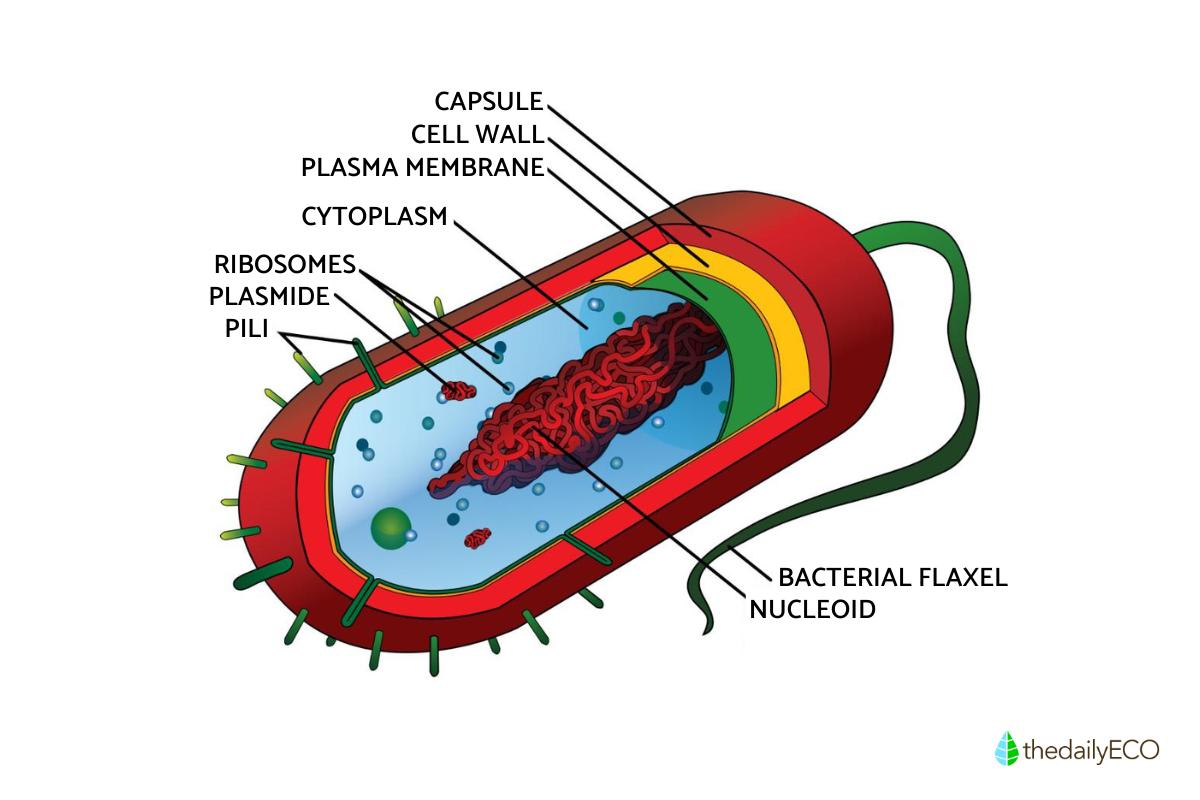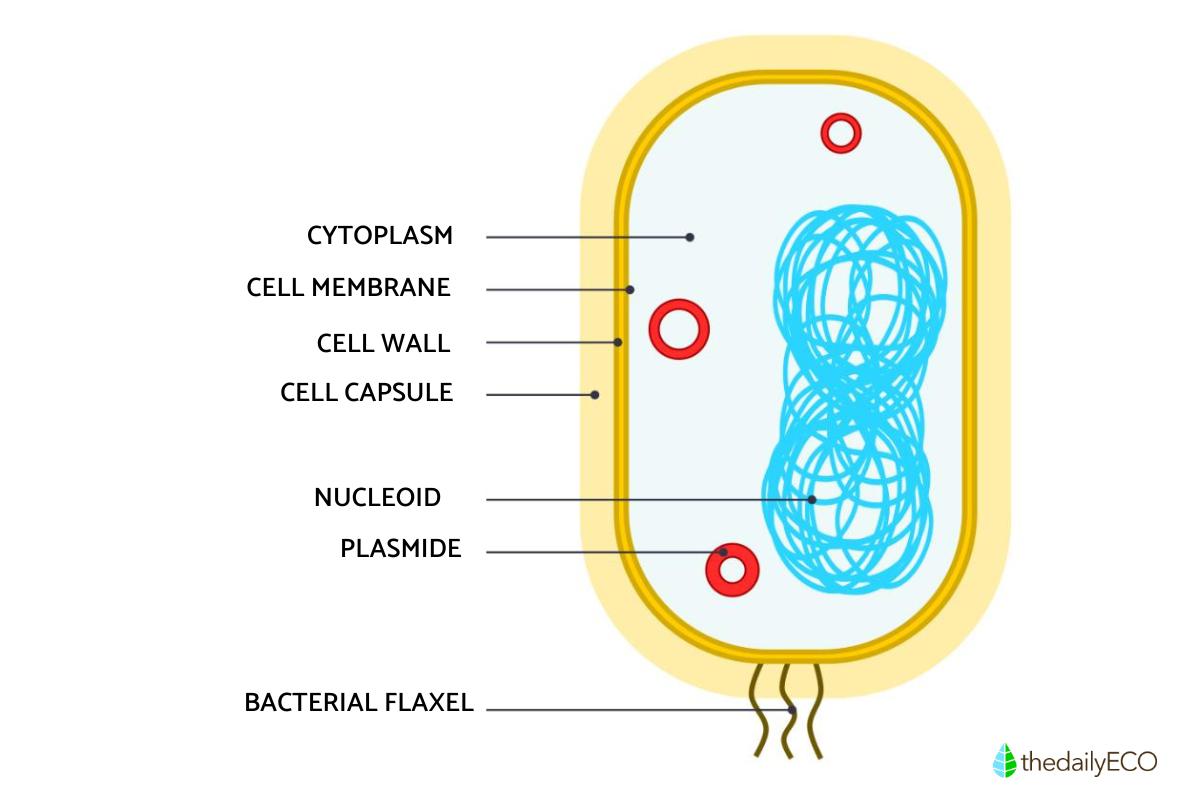What is a Nucleoid? - The DNA of Prokaryotic Cells


The nucleoid is a characteristic feature of prokaryotic cells, houses the organism's genetic material and plays pivotal roles in genetic storage, DNA replication, transcription, and gene regulation. It is formed through the condensation and functional organization of a single chromosomal DNA molecule.
In the following article by thedailyECO, we explore what a nucleioid is, key functions, and unique characteristics. We'll also shed light on how it differs from the nucleus found in more complex cells.
What is the nucleoid?
Prokaryotic cells, such as bacteria, present a fascinating approach to organizing their genetic material. Unlike their eukaryotic counterparts (animal and plant cells) with well-defined nuclei enclosed by a double membrane, prokaryotes lack this specialized compartment.
Instead, prokaryotic cells possess a distinct region known as the nucleoid. This area within the cell's cytoplasm, the fluid-filled interior, houses the cell's most critical asset: its genetic information. This information, typically a single, circular chromosome, consists of DNA, the molecule that encodes the instructions for building and maintaining the cell.
The nuclear membrane in eukaryotes acts as a barrier, segregating the DNA from the rest of the cellular activities. Conversely, the nucleoid's DNA resides more freely within the cytoplasm, facilitating faster interaction with the cellular machinery responsible for utilizing the genetic instructions. While the nucleoid may appear less organized compared to a nucleus, it is a highly structured region nonetheless.
What makes up a nucleoid?
The nucleoid's composition reflects its primary function: housing the cell's genetic blueprint. DNA, the molecule that carries the instructions for building and maintaining the cell, makes up around 60% of the nucleoid.
However, the nucleoid isn't just a simple storage locker for DNA. Smaller amounts of RNA and proteins are also present, playing crucial roles in managing the cell's genetic operations. The RNA component primarily consists of messenger RNA (mRNA) and regulatory RNAs. These molecules act as intermediaries, carrying the genetic code from DNA out into the cytoplasm where protein synthesis occurs. Regulatory RNAs play a more nuanced role, acting like switches that turn genes on or off depending on the cell's needs.
Nucleoid-associated proteins (NAPs) play a critical role in maintaining the structure and organization of the nucleoid. These proteins function by compacting the bacterial chromosome, which is typically a single, circular molecule of DNA. This compaction is essential for fitting the large amount of genetic information within the limited space of a bacterial cell.
Want to go beyond the nucleoid? Explore this other article that explains what prokaryotic cells are.

Functions of the nucleoid
The nucleoid serves as the cell's central command center, housing its genetic material and orchestrating essential functions. Here's a closer look at the key functions of the nucleoid:
- The nucleoid acts as the primary repository for the cell's genetic information. This information is typically stored in a single, circular DNA molecule that holds the blueprint for the cell's structure, function, and regulation.
- Within the nucleoid, DNA is transcribed into RNA, including messenger RNA (mRNA), which is then translated into proteins responsible for various cellular activities. During transcription, an enzyme called RNA polymerase reads the DNA sequence and uses it to build a complementary RNA molecule. The RNA molecule is a temporary copy that carries a specific section of the genetic code from DNA. Nucleoid-associated proteins (NAPs) play a crucial role in this process by regulating access to DNA by the transcription machinery. NAPs essentially act as gatekeepers, ensuring only the necessary genes are expressed at the right time.
- The nucleoid is the designated zone for DNA replication. This tightly controlled process ensures the accurate duplication of the entire genetic material before cell division. Each daughter cell receives a complete set of genes, ensuring the continuity of life.
- Given the limited space within a bacterial cell, NAPs and other structural proteins come into play to compact the lengthy DNA molecule. This compaction strategy, often involving supercoiling (tightly coiling DNA loops), allows the large bacterial chromosome to fit efficiently within the cell and facilitates essential cellular functions.
- During cell division (binary fission), the nucleoid plays a critical role in ensuring the replicated chromosomes are accurately distributed to daughter cells. Proper organization and compaction facilitated by NAPs are essential for maintaining genetic integrity during this process.
- The nucleoid is not a static structure. By altering the DNA's structure and organization, the cell can regulate gene expression in response to environmental stresses and changes. This allows the bacteria to adapt to new conditions by expressing genes necessary for survival, such as those involved in heat resistance or nutrient acquisition. Additionally, the nucleoid can activate DNA repair mechanisms to address damage caused by environmental factors like UV radiation or mutagens. This combined function ensures both adaptation and the maintenance of genetic integrity.
- The genes located within the nucleoid encode the blueprints for enzymes and proteins involved in various metabolic pathways, which are the chemical processes that sustain the cell's life. By regulating these genes, the nucleoid ensures the cell's metabolic needs are met efficiently, responding to both internal cues (like energy levels) and external signals (like nutrient availability).
This section explored the functions of the nucleoid, but the cell world is vast! Do not miss this other article on cell types, which unpacks the different structures and functions of various cell types.
Structure of the nucleoid
The nucleoid in prokaryotic cells, unlike the well-defined nucleus of eukaryotes, lacks a surrounding membrane. This creates a more diffuse and irregular structure, but it's by no means disorganized.
The primary challenge for the nucleoid is accommodating a lengthy, single, circular DNA molecule within the limited space of a bacterial cell. This is achieved through DNA condensation, a process orchestrated by special proteins called nucleoid-associated proteins (NAPs).
NAPs act like molecular architects. Unlike histones in eukaryotes that form tight spools around DNA (nucleosomes), NAPs employ different strategies. They may bend and loop the DNA molecule, achieving a more compact form without requiring extreme supercoiling (tightly coiling DNA strands).
The nucleoid structure isn't random. DNA folding and interactions are organized at multiple levels:
- Short-range interactions: DNA segments within a local area interact with each other, influenced by NAPs.
- Long-range interactions: distant DNA segments can also loop and connect with each other, further contributing to compaction.
- Macrodomains: these are specific regions within the nucleoid where DNA segments with similar functions or regulatory needs cluster together. This spatial organization plays a role in gene regulation.
Due to the dynamic nature of DNA folding and interactions, the nucleoid doesn't have a fixed shape. It's generally described as an irregularly shaped region within the cytoplasm. However, the hierarchical organization and the influence of NAPs ensure a level of order and functionality within the nucleoid.

What is the difference between the Nucleus and Nucleoid?
The nucleus and nucleoid serve similar fundamental purposes in storing and regulating genetic material, but they differ in structural organization, compartmentalization, and the mechanisms of gene regulation. The nucleus, with its membrane-bound structure and complex organization, is characteristic of eukaryotic cells, while the nucleoid, simpler and lacking a membrane, is a hallmark of prokaryotic cells. Here are some other key differences:
Structure and organization:
- Nucleus: contains multiple linear chromosomes, each with a complex structure involving DNA wrapped around histone proteins to form nucleosomes. Chromatin (DNA-protein complex) can be found in a more relaxed state (euchromatin) or a more condensed state (heterochromatin). The nucleolus, a substructure within the nucleus, is involved in ribosomal RNA synthesis and ribosome assembly.
- Nucleoid: contains a single, circular DNA molecule, although some bacteria may have linear DNA or additional plasmids. DNA is supercoiled and compacted with the help of nucleoid-associated proteins (NAPs) but does not form nucleosomes like in eukaryotes.
Genetic material:
- Nucleus: contains multiple chromosomes, each consisting of linear DNA molecules. The DNA is associated with histones and other proteins that help in organizing and regulating the genetic material.
- Nucleoid: typically contains a single, circular DNA molecule, though some prokaryotes may have multiple or linear chromosomes. The DNA is associated with NAPs, which aid in organization and compaction.
Gene regulation:
- Nucleus: gene expression is regulated by a complex interplay of transcription factors, chromatin remodeling complexes, and epigenetic modifications. mRNA is processed (splicing, capping, and polyadenylation) before being transported out of the nucleus for translation.
- Nucleoid: gene expression is regulated primarily at the level of transcription, with NAPs playing a key role. mRNA does not undergo extensive processing and is translated almost immediately in the cytoplasm.
Cell division:
- Nucleus: During mitosis and meiosis, the nuclear envelope breaks down and reforms. Chromosomes are duplicated, condensed, and segregated into daughter nuclei.
- Nucleoid: DNA replication and segregation occur without the breakdown of a nuclear envelope. The nucleoid duplicates and is distributed to daughter cells during binary fission.
This article explored the differences between nucleus and nucleoid, but the plot thickens. Our recommended article delves into the differences between eukaryotic and prokaryotic cells.
If you want to read similar articles to What is a Nucleoid? - The DNA of Prokaryotic Cells, we recommend you visit our Biology category.
- Give me RT (2005). The role of nucleoid‐associated proteins in the organization and compaction of bacterial chromatin. Molecular Microbiology 56 (4).







